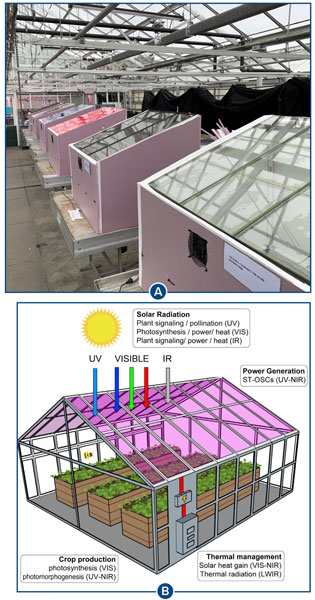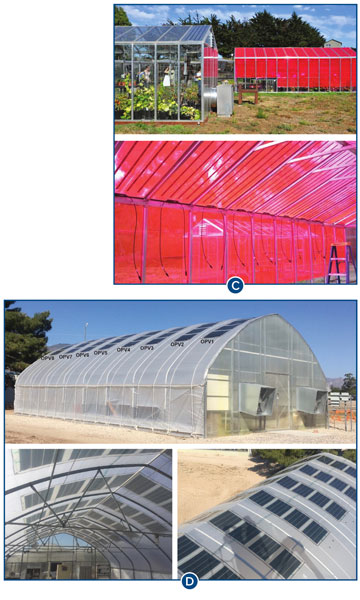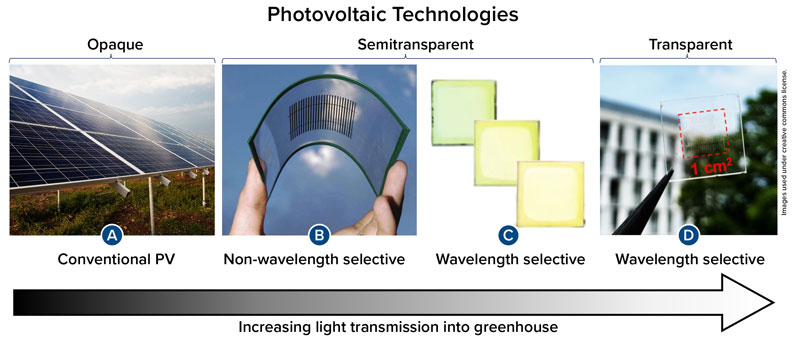6/1/2024
Solar Appeal
Eric J. Stallknecht, Richard R. Lunt & Erik S. Runkle

There’s enough solar energy hitting the planet to power the entire world many times over. The installation of solar panels—more technically called photovoltaic (PV) panels—over agricultural land, pasture and greenhouse spaces has the potential to generate nearly 70 terawatts in the U.S. alone. This potential is sparking great excitement for the development and deployment of these new PV technologies.
Producing floriculture crops and other high-value specialty crops while simultaneously generating electricity has a lot of appeal. The practice of creating dual-purpose agricultural and solar energy production is termed “agrivoltaics” and broadly refers to the co-localization of PV panels into agricultural spaces used to grow crops or food for animal production.
Currently, very few commercialized, crop-centric agrivoltaic products exist. As such, it’s important to understand how developing PV technologies may influence the greenhouse and agricultural industries in the near future, including opportunities and constraints. In this first of two articles, we introduce the PV technologies that currently exist and discuss how different PV technologies may eventually be incorporated into greenhouses. In the second part of the series, we’ll discuss how semi-transparent and transparent PVs could affect greenhouse crops.
Pictured: Agrivoltaic greenhouse research conducted at various U.S. universities. A) Michigan State University; B) North Carolina State University.
Greenhouse growers are intimately familiar with light transmission into a greenhouse because it directly influences crop growth, crop quality, and ultimately, profitability. In most cases, incorporating PVs into a greenhouse will create additional shading, resulting in crops receiving less light. Whether that additional shading is beneficial, tolerable or detrimental is highly dependent on crops grown, greenhouse location, greenhouse design and time of year. However, PVs can now also be developed that limit shading to the plant and only harvest the wavelengths that the plants don’t use. Thus, a holistic consideration of factors that influence light inside a greenhouse are needed for proper implementation of PVs into greenhouses.
Types of PV technologies
Conventional opaque PVs: Opaque panels are what most people imagine when they think about PVs (Figure 1A). This technology intercepts ultraviolet, visible and near-infrared energy from the sun and creates areas of nearly 100% shade underneath. Most experimental agrivoltaic greenhouses have used conventional opaque PVs because they’re readily available, have high efficiencies and are technologically mature, not because they’re ideal for use in greenhouses. One of the initial challenges of using conventional opaque PV panels in greenhouses is the severe decrease in light intensity and uniformity due to the strong shading.
 Pictured: C) University of California, Santa Cruz; and D) The University of Arizona.
Pictured: C) University of California, Santa Cruz; and D) The University of Arizona.
Semi-transparent PVs: Unlike conventional PVs, semi-transparent PVs allow a fraction (typically less than half) of photosynthetic light to pass through the panels for use by crops (Figures 1B and 1C). One method to create a semitransparent PV panel is to spatially segment conventional opaque PV cells (Figure 1B). This method doesn’t alter the light spectrum, but does decrease light transmission, depending on the space between PV cells. An alternative approach is to make thin or ultrathin PV cells to allow greater light transmission. This approach often leads to greater absorption of blue light relative to red light.
Semitransparent PVs can be designed to be wavelength-selective (Figure 1C), allowing certain colors of light (red, green or blue) to transmit through while others are absorbed to generate electricity. Modification of the solar spectrum can influence photosynthesis and/or crop architecture—for example, branching or stem elongation. This type of PV panel modifies light quality and intensity simultaneously, which can have positive or negative effects on crop growth.
Transparent PVs: In contrast to semitransparent PVs, transparent PV panels are specifically designed to allow as much photosynthetic light to pass through them as possible. The rest of the unused energy from the sun (wavelengths longer than 700 nm and/or shorter than 400 nm) is selectively harvested and used for electrical generation (Figure 1D). Consequently, transparent PVs generate less electricity than their opaque counterparts, but transmit the most photosynthetic light for crop production, quality and yield.
From a plant management perspective, transparent PVs are the least complex to incorporate into greenhouses. Historically, these technologies have been developed for use in building windows and not for agriculture, and thus are optimized more for human vision than for plants. However, transparent PV panels are now being actively investigated at research scale for plant-based applications.
Incorporating PVs into greenhouse structures
The best method to incorporate PVs into a greenhouse is typically going to be situational, depending on the crops grown, total solar insolation, weather and geography. However, research groups around the U.S. and beyond are addressing knowledge gaps. The creation of agrivoltaic greenhouses with unique approaches are being proposed, some of which are briefly described below (Figure 2).
Use as a greenhouse glazing: Probably the most straightforward use of semi-transparent and transparent PV panels in a greenhouse is as a replacement for common greenhouse glazing. Transparent PV panels offer the most seamless transition into an agrivoltaic greenhouse structure because they transmit the most photosynthetically active radiation for crop growth, while absorbing the rest of the sunlight spectrum to generate electricity (Figure 2A). There’s also interest in utilizing wavelength-selective semitransparent PVs as a greenhouse glazing material (Figures 2B and C). Some wavelength-selective PVs are designed to absorb more green light for electrical generation and transmit more blue and red light for crop growth.
Use as a seasonal shading material: Shading practices such as the use of whitewash on the exterior of a greenhouse and/or the use of interior retractable shade curtains are common. PVs have the potential to replace these shading materials and/or practices with the added benefit of generating electricity. There’s been less research and development on seasonal PV applications for greenhouses, but spatially segmented PVs have been used with some success on the exterior of a greenhouse (Figure 2D). The use of flexible PVs as shade curtains offers a potentially synergistic way to keep greenhouse crops cooler under peak solar loads while also generating electricity to power active greenhouse cooling (exhaust fans, evaporative cooling pads, etc.).
Future perspectives
While still very early in the research and development phases, preliminary findings suggest there are improving approaches to successfully incorporate PVs into greenhouses depending on the specific PV type, crop type and geographical location. Transparent PV panels, while generating less electricity than conventional opaque PVs, have the potential to replace commonly used greenhouse glazing materials. Additionally, semitransparent PVs could be used as shading materials for shade-tolerant crops without negatively affecting light uniformity, which is problematic with conventional opaque PVs.
Despite developments in agrivoltaics, there are still many fundamental questions—including ones about their economics and impact of plant productivity—that need to be addressed before commercial application is viable. Progress will continue as more research collaborations emerge, arable land becomes scarcer and demand for renewable energy continues to increase. GT
Eric Stallknecht is an Assistant Professor and Greenhouse Specialist at the Hampton Roads Agricultural Research and Extension Center at Virginia Tech University. Richard Lunt is the Johansen Crosby Professor of Chemical Engineering and Materials Science at Michigan State University. Erik Runkle is a Professor and Extension Specialist in the Department of Horticulture at Michigan State University.
Pictured below: Figure 1. Potential photovoltaic (PV) technologies for integration into greenhouses. From left to right: Developing greenhouse technologies with greater transmission of photosynthetic light (i.e., less shading). A) conventional PV; B) A spatially segmented PV; C) a wavelength selective PV; and D) a nearly transparent PV.
